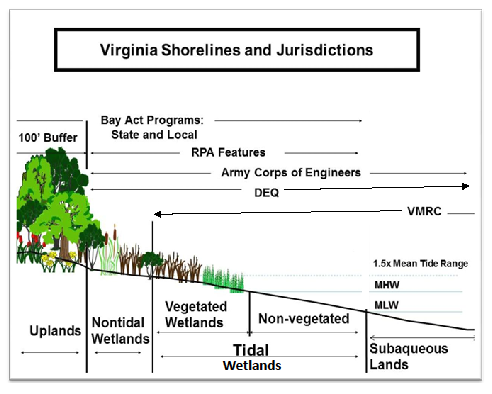The Environmental Programs division provides administration of state and county codes pertaining to environmental issues and assists the community in education and enforcement of such ordinances and procedures. Citizens are welcome to call or email with questions or for guidance on how to submit applications.
Environmental Codes & Compliance Officer, Josh Rellick
Address and Contact Information
242 Allens Circle, Suite L
P.O. Box 177
King & Queen C.H., VA 23085
Phone: (804) 785-5975 or (804) 769-5000
Fax: (804) 785-5999
Email: [email protected]
Services Offered
Environmental Programs offers the following public services:
- Chesapeake Bay and Tidal Wetlands site evaluations and inspections
- Land disturbance site evaluations and inspections
- Stormwater site evaluations and inspections
Land Disturbance Information
BEFORE you clear, grade, excavate or fill, note that:
- Any land disturbing activity in the Resource Management Area (RMA) (clearing, grading, excavating, filling, etc.) greater than 2,500 square feet in area requires a land disturbing permit from the King and Queen County Zoning and Zoning office.
- Any land disturbing activity outside of the Resource Management Area (RMA) (clearing, grading, excavating, filling, etc.) greater than 10,000 square feet in area requires a land disturbing permit from the King and Queen County Planning and Zoning office.
To obtain a permit:
1) Fill out the correct land disturbing permit application.
- For land disturbance activity for a single-family dwelling project, click here for an application.
- For all other land disturbance activities, click here for an application.
- Click for an Erosion and Sediment Control Plan Review Checklist
2) Be sure to provide clear, specific directions to your site. Inadequate directions may delay the processing of your permit.
3) If building a residence, submit a copy of your Virginia Department of Health Permit or Safe Adequate and Proper (SAP) approvals providing evidence of an approved septic system. Contact the King and Queen Health Department for an application and more information at (804) 785-6154.
4) Submit approval from VDOT for your proposed driveway if your drive will enter from a state road. A contractor or land owner constructing a house must obtain a LUP-PE permit from the VDOT office in Saluda located at 161 Bowden Street, Saluda, VA or call them at (804) 758-2321.
5) For residential projects: On a copy of a survey or plat of your property, draw the limits of your proposed clearing, grading, or other land disturbance and provide dimensions of the area to be disturbed (also known as the “in lieu of” land disturbance application/permit). For all other projects: Submit an erosion and sediment control plan meeting the requirements of the Virginia Erosion and Sediment Control Regulations. Click here for a copy of the Virginia erosion and sediment control regulations.
6) If your property has any wetlands, streams or other water bodies, you may be required to be set back a minimum of 100 feet from these features due to the Chesapeake Bay Preservation Act. This 100′ buffer is called the Resource Protection Area (RPA). No construction, land disturbance, storage of equipment or materials is allowed in the 100′ RPA.
7) Post a sign at the proposed driveway location with the last name of the property owner.
8) Mark/flag the limits of your proposed land disturbance on site. These limits should match the limits shown on your drawing.
Paying Fees
At the time of submitting an application, and prior to any requisite consideration or action by the King & Queen County Planning Commission or King & Queen County Board of Supervisors, an applicant shall pay any appropriate fees in full. Click here for a complete schedule of zoning and planning fees.
Responsible Land Disturber (RLD) Requirements
A Virginia Department of Conservation and Recreation (DCR)-certified RLD is required for all non-residential projects and residential projects disturbing over an acre and violations. A copy of a RLD’s certification must be submitted with application for these projects. For more information on the RLD requirements click here.
After your permit has been issued:
- Post your land disturbing permit on your site.
- Install any required erosion and sediment control measures that are required (i.e. construction entrance, silt fence, etc.)
- Keep land disturbing activity within the approved limits.
- Periodically inspect your property for erosion problems.
- County staff will conduct periodic inspections of your project and inform you of any erosion and sediment control issues on your site.
Before you are ready for a certificate of occupancy:
- All denuded, disturbed area must be appropriately graded, seeded and mulched.
- A Permanent Certificate of Occupancy will NOT be issued until your site is adequately stabilized.
Wetlands Information
Tidal wetlands serve as spawning and nursery grounds for a variety of marine life. In addition to their habitat value, these areas also assist in flood control, improve water quality, reduce erosion, and serve as an important food source for marine and inland wildlife.
Activities altering, using, filling or impacting tidal wetlands, such as but not limited to bulkheads, riprap, boat ramps, and road crossings, may require review by and approval from the U.S. Army Corps of Engineers, the Virginia Marine Resource Commission (VMRC) and potentially other agencies.
Related Permits
- Joint Permit Application (JPA)
- WQIA (Water Quality Impact Assessment) Application
- RPA Modification Application
Submit your JPA for shoreline stabilization or pier projects to VMRC:
Virginia Marine Resources Commission
380 Fenwick Road, Building 96
Fort Monroe, VA 23651
JPAs can also be emailed to [email protected]
VMRC will route copies of the JPA to King and Queen County and the other participating federal, state, and local agencies. Each agency processes the application independently and decides whether a permit for the proposal is required. Each agency will respond separately to the applicant.

